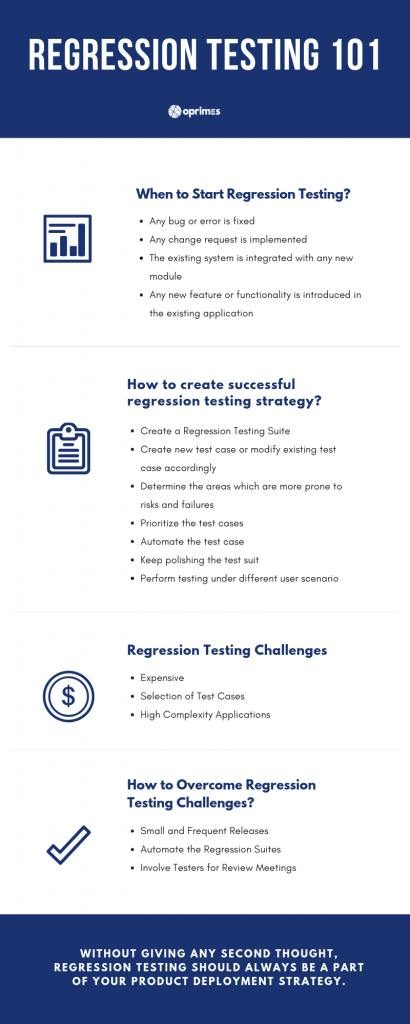
With the world undergoing complete digital transformation, there is an increased focus on end-to-end testing. Digital transformation makes your business operations ready for the future and much more creative. Digital app innovation across Mobile, Social, Cloud and IoT are setting trends for futuristic solutions across industries.
Testing of any digital application comprises two main areas:
- Functional testing to assess the new features
- Regression testing to check the consistency of existing ones
Usually, Regression testing is considered as burden and does not get due attention from the product owner. Automated regression testing is often also viewed as a burden in some cases for each major build where there is a considerable maintenance cost involved in the test and result analysis. Re-performing tests are often thought of as redundant and a waste of time. However, launching your product without proper testing, more importantly, regression testing could lead to lots of complaints from your end users, which is not a good sign for your product and business.
The only way to achieve high-quality digital applications is to deploy an effective software testing model that covers both functional and regression testing for each release.
What is the need for full regression testing?
To maintain the best balance between fast development and frequent app testing requests, it is important to include regression testing strategy in the product release plan itself. Playing a critical role in the release process, full regression testing is equally needed in the development phase.
Regression testing strategy is usually planned when,
- Any bug or error is fixed
- Any change request is implemented
- The existing system is integrated with any new module
- Any new feature or functionality is introduced in the existing application
Case Study
I was consulting one of the largest telecom firms as their QA partner for their digital app portfolio. Their business-critical mobile app was updated on a weekly basis and they were releasing fortnightly builds to production. Owing to deployment delays and pressure of achieving faster time to market, the product team only focused on new changes implemented for each release while ignoring the stable features.
There was a large number of issues cropping up in the production and the app was losing its store rating due to bad overall user experience. The client asked us to help them resolve the situation.
Upon conducting due diligence, I realized that in the urgency to deploy new features to production, the existing features were rarely tested, while they were getting impacted due to changes made to new features and this was impacting the overall user experience.
Regression testing to the rescue.
We decided to come up with a risk-based regression testing strategy for this app. Agile involves shorter and frequent testing cycles, which implies that the quality of the sprints needs to be ensured quickly each time the code/software is released.
Regression testing comes in handy specifically during these constant churns and ensures that the earlier release is in sync with the new code.
An effective regression testing strategy calls for careful planning and prioritization, as well as the active involvement of the whole team.
The steps that we followed to create a successful regression testing strategy are:
- Create a regression test suite and closely monitor any changes in the application for a release.
- Examine the changes and analyze their impact on different components. Create new test cases or modify the existing test cases accordingly.
- Determine the areas which are more prone to risks and failures.
- Prioritize the test cases, estimate the time for their execution.
- Identify the test cases that can be automated and put it in motion.
- Keep polishing the test suite occasionally by erasing outdated test cases and adding new ones.
- Perform random testing under different user scenarios.
Teams need to ensure an effective balance between speed and quality, which means they need faster and credible feedback. Particularly in an agile environment, it is important that the feedback comes in faster, so that the required action is taken. Hence, within an agile set-up, the regression tests are run just after the changes are done and before the sprint is released. This helps in getting a quicker response for better turnaround time and implementation. Automated regression tests enable faster results and repeated testing for similar releases.
Regression testing challenges.
There are various challenges the enterprises and start-ups face while adopting regression tests.
- Expensive: Due to faster deployments, regression testing is treated as a burden, a redundant step that delivers little value. Allocation of resources and budget can be difficult to justify and gets deprioritized.
- Selection of Test cases: Time is an unaffordable luxury in this type of testing. Due to this, there is no window to run large test suites. To make the most efficient use of the time in hand, testers need to prioritize and have full traceability. They should carefully select which test cases to run and more importantly, which test cases to skip.
- High Complexity applications: As new updates keep adding to application code, test cases have to be maintained accordingly. With the expansion of features and functionalities, the complexities of both code and test cases increase. In such a scenario, it is very easy to lose track of regression suite maintenance.
Smart work is needed to overcome these challenges
- Small and Frequent Releases: It is easy to perform regression testing on smaller codes as compared to full releases. Developers should be informed to keep deploying sections of an upcoming release to the test environment so that it becomes possible to test and provide feedback simultaneously.
- Automate the Regression Suites: Find the ways to automate test cases which are required for repetitive execution. Regression testing requires intelligence to identify which test cases to execution based on thorough impact analysis after an update. Regression test cases should be automated to save time. Automated regression tests enable faster results and repeated testing for similar releases. This helps to track any kind of unexpected behavior or error with the application on a constant basis.
- Involve Testers for Review Meetings: Testers should actively participate in the code review meetings. It does not matter if they have any knowledge of coding. Being involved in code reviews will keep them updated on the changes made to the code. This further enables them to focus their attention to those changes at the time of regression testing.
Without giving any second thought, regression testing should always be a part of your product deployment strategy. An application should deliver value to the customers. If you keep spending money on people and resources without picking the right strategy, you will not achieve the results as expected.


